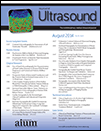Clinical and Radiologic Features of Neuroendocrine Breast Carcinomas
Chang Ho Jeon MD
Department of Radiology, Seoul National University Bundang Hospital, Gyeonggi-do, Korea
Search for more papers by this authorCorresponding Author
Sun Mi Kim MD, PhD
Department of Radiology, Seoul National University Bundang Hospital, Gyeonggi-do, Korea
Address correspondence to Sun Mi Kim, MD, PhD, Department of Radiology, Seoul National University Bundang Hospital, 300 Gumi-ro, Bundang-gu, Seongnam-si, Gyeonggi-do 463-707, Korea.Search for more papers by this authorMijung Jang MD
Department of Radiology, Seoul National University Bundang Hospital, Gyeonggi-do, Korea
Search for more papers by this authorBo La Yun MD
Department of Radiology, Seoul National University Bundang Hospital, Gyeonggi-do, Korea
Search for more papers by this authorHye Shin Ahn MD
Department of Radiology, Seoul National University Bundang Hospital, Gyeonggi-do, Korea
Search for more papers by this authorSung-Won Kim MD
Department of Surgery, Seoul National University Bundang Hospital, Gyeonggi-do, Korea
Search for more papers by this authorEunyoung Kang MD
Department of Surgery, Seoul National University Bundang Hospital, Gyeonggi-do, Korea
Search for more papers by this authorSo Yeon Park MD
Department of Pathology, Seoul National University Bundang Hospital, Gyeonggi-do, Korea
Search for more papers by this authorChang Ho Jeon MD
Department of Radiology, Seoul National University Bundang Hospital, Gyeonggi-do, Korea
Search for more papers by this authorCorresponding Author
Sun Mi Kim MD, PhD
Department of Radiology, Seoul National University Bundang Hospital, Gyeonggi-do, Korea
Address correspondence to Sun Mi Kim, MD, PhD, Department of Radiology, Seoul National University Bundang Hospital, 300 Gumi-ro, Bundang-gu, Seongnam-si, Gyeonggi-do 463-707, Korea.Search for more papers by this authorMijung Jang MD
Department of Radiology, Seoul National University Bundang Hospital, Gyeonggi-do, Korea
Search for more papers by this authorBo La Yun MD
Department of Radiology, Seoul National University Bundang Hospital, Gyeonggi-do, Korea
Search for more papers by this authorHye Shin Ahn MD
Department of Radiology, Seoul National University Bundang Hospital, Gyeonggi-do, Korea
Search for more papers by this authorSung-Won Kim MD
Department of Surgery, Seoul National University Bundang Hospital, Gyeonggi-do, Korea
Search for more papers by this authorEunyoung Kang MD
Department of Surgery, Seoul National University Bundang Hospital, Gyeonggi-do, Korea
Search for more papers by this authorSo Yeon Park MD
Department of Pathology, Seoul National University Bundang Hospital, Gyeonggi-do, Korea
Search for more papers by this authorAbstract
Neuroendocrine breast carcinoma is a rare and distinct type of breast carcinoma, with morphologic features similar to those of pulmonary and gastrointestinal tract neuroendocrine tumors. More than 50% of cells express neuroendocrine markers. We documented the clinical and radiologic features of 11 patients with histologically confirmed neuroendocrine breast carcinomas. Clinical manifestations included nipple discharge (6 patients) and palpable masses (5 patients). Lesions were mainly oval or irregular on mammography (n = 8), sonography (n = 11), and magnetic resonance imaging (n = 9). Understanding the clinical and radiologic features of neuroendocrine breast carcinoma will facilitate the differential diagnosis.
References
- 1Akhtar K, Zaheer S, Ahmad SS, Hassan MJ. Primary neuroendocrine carcinoma of the breast. Indian J Pathol Microbiol 2009; 52: 71–73.
- 2Ogawa H, Nishio A, Satake H. Neuroendocrine tumor in the breast. Radiat Med 2008; 26: 28–32.
- 3Upalakalin JN, Collins LC, Tawa N, Parangi S. Carcinoid tumors in the breast. Am J Surg 2006; 191: 799–805.
- 4Kadir AAR, Iyengar KR, Peh SC, Yip CH. Fine needle aspiration cytology of neuroendocrine carcinoma of the breast: a case report and review of literature. Malaysian J Pathol 2008; 30: 37–61.
- 5Salman B, Sakrak O, Yilmaz U, Cakir A, Kerem M, Aydin A. Primary neuroendocrine carcinoma in the breast: a case report. J Breast Cancer 2010; 13: 115–119.
- 6Mendelson E, Baum J, Berg W. BI-RADS: ultrasound. In: CJ D'Orsi, EB Mendelson, DM Ikeda (eds). Breast Imaging Reporting and Data System: ACR BI-RADS—Breast Imaging Atlas. Reston, VA: American College of Radiology; 2003.
- 7Tavassoli FA, Devilee P. Pathology and Genetics: Tumours of the Breast and Female Genital Organs. Lyon, France: International Agency for Research on Cancer; 2003.
- 8Günhan-Bilgen I, Zekioglu O, Ustün E, Memis A, Erhan Y. Neuroendocrine differentiated breast carcinoma: imaging features correlated with clinical and histopathological findings. Eur Radiol 2003; 13: 788–793.
- 9Sapino A, Bussolati G. Is detection of endocrine cells in breast adenocarcinoma of diagnostic and clinical significance? Histopathology 2002; 40: 211–214.
- 10Papotti M, Macri L, Finzi G, Capella C, Eusebi V, Bussolati G. Neuroendocrine differentiation in carcinomas of the breast: a study of 51 cases. Semin Diagn Pathol 1989; 6: 174–188.
- 11Richards T, Hunt A, Courtney S, Umeh H. Nipple discharge: a sign of breast cancer? Ann R Coll Surg Engl 2007; 89: 124–126.
- 12Lopez JK, Bassett LW. Invasive lobular carcinoma of the breast: spectrum of mammographic, US, and MR imaging findings. Radiographics 2009; 29: 165–176.
- 13Lamb PM, Perry NM, Vinnicombe SJ, Wells CA. Correlation between ultrasound characteristics, mammographic findings and histological grade in patients with invasive ductal carcinoma of the breast. Clin Radiol 2000; 55: 40–44.
- 14Stavros AT, Thickman D, Rapp CL, Dennis MA, Parker SH, Sisney GA. Solid breast nodules: use of sonography to distinguish between benign and malignant lesions. Radiology 1995; 196: 123–134.
- 15Fujimoto Y, Yagyu R, Murase K. A case of solid neuroendocrine carcinoma of the breast in a 40-year-old woman. Breast Cancer 2007; 14: 250–253.
- 16Schnall MD, Blume J, Bluemke DA. Diagnostic architectural and dynamic features at breast MR imaging: multicenter study. Radiology 2006; 238: 42–53.
- 17Nunes LW, Schnall MD, Orel SG. Update of breast MR imaging architectural interpretation model. Radiology 2001; 219: 484–494.
- 18Maluf HM, Koerner FC. Carcinomas of the breast with endocrine differentiation: a review. Virchows Arch 1994; 425: 449–457.
- 19Mirza IA, Shahab N. Small cell carcinoma of the breast. Semin Oncol 2007; 34: 64–66.
- 20Zekioglu O, Erhan Y, Cirisş M, Bayramoglu H. Neuroendocrine differentiated carcinomas of the breast: a distinct entity. Breast 2003; 12: 251–257.
- 21Shin SJ, DeLellis RA, Ying L, Rosen PP. Small cell carcinoma of the breast: a clinicopathologic and immunohistochemical study of nine patients. Am J Surg Pathol 2000; 24: 1231–1238.




